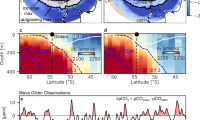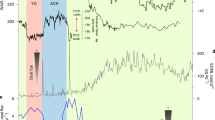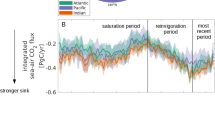Abstract
The Southern Ocean, with its large surface area and vigorous overturning circulation, is potentially a substantial sink of anthropogenic CO2 (refs 1–4). Despite its importance, the mechanism and pathways of anthropogenic CO2 uptake and transport are poorly understood. Regulation of the Southern Ocean carbon sink by the wind-driven Ekman flow, mesoscale eddies and their interaction is under debate5,6,7,8. Here we use a high-resolution ocean circulation and carbon cycle model to address the mechanisms controlling the Southern Ocean sink of anthropogenic CO2. The focus of our study is on the intra-annual variability in anthropogenic CO2 over a two-year time period. We show that the pattern of carbon uptake is correlated with the oceanic vertical exchange. Zonally integrated carbon uptake peaks at the Antarctic polar front. The carbon is then advected away from the uptake regions by the circulation of the Southern Ocean, which is controlled by the interplay among Ekman flow, ocean eddies and subduction of water masses. Although lateral carbon fluxes are locally dominated by the imprint of mesoscale eddies, the Ekman transport is the primary mechanism for the zonally integrated, cross-frontal transport of anthropogenic CO2. Intra-annual variability of the cross-frontal transport is dominated by the Ekman flow with little compensation from eddies. A budget analysis in the density coordinate highlights the importance of wind-driven transport across the polar front and subduction at the subtropical front. Our results suggest intimate connections between oceanic carbon uptake and climate variability through the temporal variability of Ekman transport.
This is a preview of subscription content, access via your institution
Access options
Subscribe to this journal
Receive 51 print issues and online access
$199.00 per year
only $3.90 per issue
Buy this article
- Purchase on Springer Link
- Instant access to full article PDF
Prices may be subject to local taxes which are calculated during checkout




Similar content being viewed by others
References
Toggweiler, J. R. & Samuels, B. Effect of Drake Passage on the global thermohaline circulation. Deep-Sea Res. I 42, 477–500 (1995)
Sarmiento, J. L. et al. Response of ocean ecosystems to climate warming. Glob. Biogeochem. Cycles 18, GB3003 (2004)
Russell, J. L., Dixon, K. W., Gnanadesikan, A., Stouffer, R. J. & Toggweiler, J. R. The Southern Hemisphere westerlies in a warming world: propping open the door to the deep ocean. J. Clim. 19, 6382–6390 (2006)
Marinov, I., Gnanadesikan, A., Toggweiler, R. & Sarmiento, J. L. The Southern Ocean biogeochemical divide. Nature 441, 964–967 (2006)
Ito, T., Marshall, J. & Follows, M. What controls the uptake of transient tracers in the Southern Ocean? Glob. Biogeochem. Cycles 18, GB2021 (2004)
Le Quéré, C. et al. Saturation of the Southern Ocean CO2 sink due to recent climate change. Science 316, 1735–1738 (2007)
Lovenduski, N. S., Gruber, N. & Doney, S. C. Toward a mechanistic understanding of the decadal trends in the Southern Ocean carbon sink. Glob. Biogeochem. Cycles 22, GB3016 (2008)
Böning, C. W., Dispert, A., Visbeck, M., Rintoul, S. R. & Schwarzkopf, F. U. The response of the Antarctic Circumpolar Current to recent climate change. Nature Geosci. 1, 864–869 (2008)
Watson, A. J. & Orr, J. C. in Carbon Dioxide Fluxes in the Global Ocean (eds Field, J., Fasham, M., Platt, T. & Zeitzschel, B.) 123–141 (Springer, 2003)
Orr, J. C. et al. Estimates of anthropogenic carbon uptake from four three-dimensional global ocean models. Glob. Biogeochem. Cycles 15, 43–60 (2001)
Mikaloff-Fletcher, S. E. et al. Inverse estimates of anthropogenic CO2 uptake, transport, and storage by the ocean. Glob. Biogeochem. Cycles 20, GB2002 (2006)
Sabine, C. L. et al. The oceanic sink for anthropogenic CO2 . Science 305, 367–371 (2004)
Sarmiento, J. L., Orr, J. C. & Siegenthaler, U. A perturbation simulation of CO2 uptake in an ocean general circulation model. J. Geophys. Res. 97, 3621–3645 (1992)
Caldeira, K. & Duffy, P. B. The role of the Southern Ocean in uptake and storage of anthropogenic carbon dioxide. Science 287, 620–622 (2000)
Marshall, J., Shuckburgh, E., Jones, H. & Hill, C. Estimates and implications of surface eddy diffusivity in the southern ocean derived from tracer transport. J. Phys. Oceanogr. 36, 1806–1821 (2006)
Thompson, D. W. J. & Solomon, S. Interpretation of recent Southern Hemisphere climate change. Science 296, 895–899 (2002)
Marshall, G. J. Trends in the southern annular mode from observations and reanalyses. J. Clim. 16, 4134–4143 (2003)
Miller, R. L., Schmidt, G. A. & Shindell, D. T. Forced annular variations in the 20th century Intergovernmental Panel on Climate Change Fourth Assessment Report model. J. Geophys. Res. 111, D18101 (2006)
Marshall, J., Hill, C., Perelman, L. & Adcroft, A. Hydrostatic, quasi-hydrostatic, and nonhydrostatic ocean modeling. J. Geophys. Res. 102, 5733–5752 (1997)
Marshall, J., Adcroft, A., Hill, C., Perelman, L. & Heisey, C. A finite-volume, incompressible Navier Stokes model for studies of the ocean on parallel computers. J. Geophys. Res. 102, 5753–5766 (1997)
Key, R. M. et al. A global ocean carbon climatology: results from Global Data Analysis Project (GLODAP). Glob. Biogeochem. Cycles 18, GB4031 (2004)
Sokolov, S. & Rintoul, S. R. On the relationship between fronts of the Antarctic Circumpolar Current and surface chlorophyll concentrations in the Southern Ocean. J. Geophys. Res. 112, C07030 (2007)
Gruber, N. et al. Oceanic sources, sinks, and transport of atmospheric CO2 . Glob. Biogeochem. Cycles 23, GB1005 (2009)
Mazloff, M. The Southern Ocean Meridional Overturning Circulation as Diagnosed from an Eddy Permitting State Estimate. PhD thesis, Massachusetts Inst. Technol (2008)
Mazloff, M. R., Heimbach, P. & Wunsch, C. An eddy permitting Southern Ocean state estimate. J. Phys. Oceanogr (submitted)
Wunsch, C. & Heimbach, P. Practical global ocean state estimation. Physica D 230, 197–208 (2007)
Najjar, R., Sarmiento, J. & Toggweiler, J. R. Downward transport and fate of organic matter in the ocean: simulations with a general circulation model. Glob. Biogeochem. Cycles 6, 45–76 (1992)
Garcia, H. E., Locarnini, R. A., Boyer, T. P. & Antonov, J. I. in NOAA Atlas NESDIS 64 (ed. Levitus, S.) 396 (US Government Printing Office, 2006)
Moore, J. K., Abbott, M. R. & Richman, J. G. Location and dynamics of the Antarctic Polar Front from satellite sea surface temperature data. J. Geophys. Res. 104, 3059–3073 (1999)
Matsumoto, K. & Gruber, N. How accurate is the estimation of anthropogenic carbon in the ocean? An evaluation of the Delta C* method. Glob. Biogeochem. Cycles 19, GB3014 (2005)
Acknowledgements
T.I. and M.W. are supported by the US National Aeronautics and Space Administration (NASA) grant NNX08AL72G and the US National Oceanic and Atmospheric Administration grant NA08OAR4320893. The Southern Ocean State Estimate is supported by NASA and US National Oceanographic Partnership Program contracts to the Massachusetts Institute of Technology. The NASA Advanced Supercomputing division and the San Diego Supercomputer Center provided computing and data storage resources. J. L. Sarmiento and N. Lovenduski provided comments that improved the manuscript.
Author Contributions T.I. designed and performed numerical simulations of the Southern Ocean carbon cycle and analysed the model output; M.W. performed model–data comparison and calculations of carbon transport; M.M. developed the Southern Ocean State Estimate; all authors contributed to the interpretation of the results and writing of the manuscript.
Author information
Authors and Affiliations
Corresponding author
Ethics declarations
Competing interests
The authors declare no competing financial interests.
Supplementary information
Supplementary Information
This file contains Supplementary Notes and Supplementary Figures S1-S3 with Legends. (PDF 2732 kb)
Rights and permissions
About this article
Cite this article
Ito, T., Woloszyn, M. & Mazloff, M. Anthropogenic carbon dioxide transport in the Southern Ocean driven by Ekman flow. Nature 463, 80–83 (2010). https://doi.org/10.1038/nature08687
Received:
Accepted:
Issue Date:
DOI: https://doi.org/10.1038/nature08687
This article is cited by
-
Chemical weathering in Antarctica: an example of igneous rock particles in Big Lachman Lake sediments, James Ross Island
Environmental Earth Sciences (2020)
-
Stationary Rossby waves dominate subduction of anthropogenic carbon in the Southern Ocean
Scientific Reports (2017)
-
Satellite Observations of Imprint of Oceanic Current on Wind Stress by Air-Sea Coupling
Scientific Reports (2017)
-
Spiraling pathways of global deep waters to the surface of the Southern Ocean
Nature Communications (2017)
-
Water-mass transformation by sea ice in the upper branch of the Southern Ocean overturning
Nature Geoscience (2016)
Comments
By submitting a comment you agree to abide by our Terms and Community Guidelines. If you find something abusive or that does not comply with our terms or guidelines please flag it as inappropriate.



